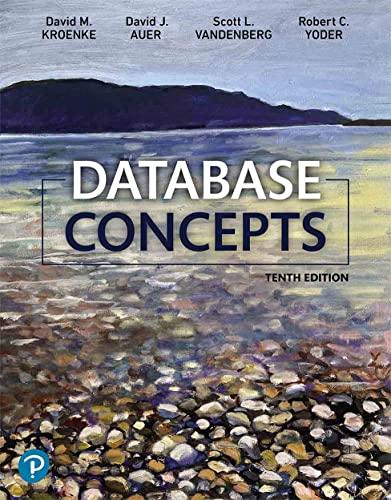Please help solving all these tasks...Thank you so much!!
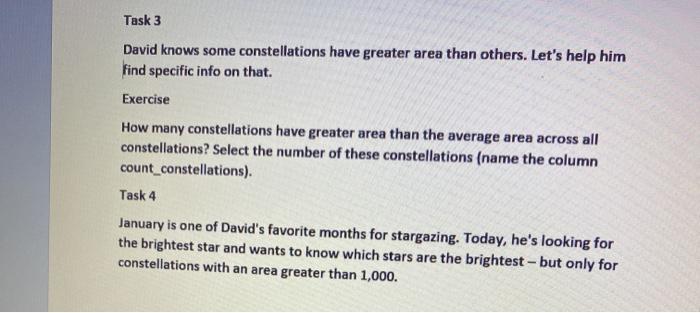
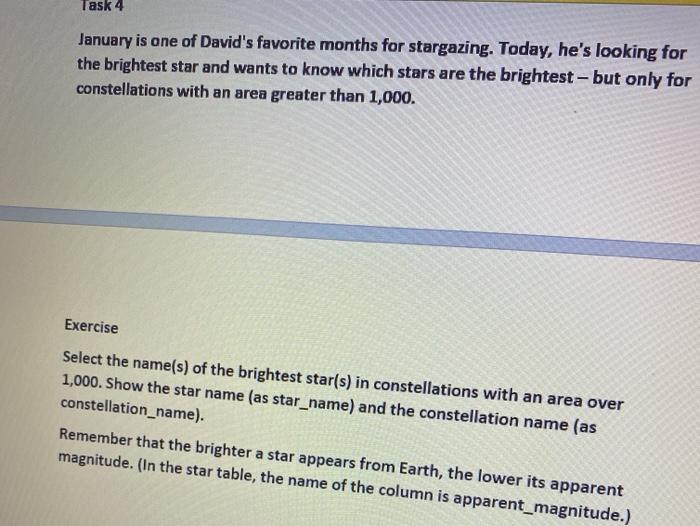
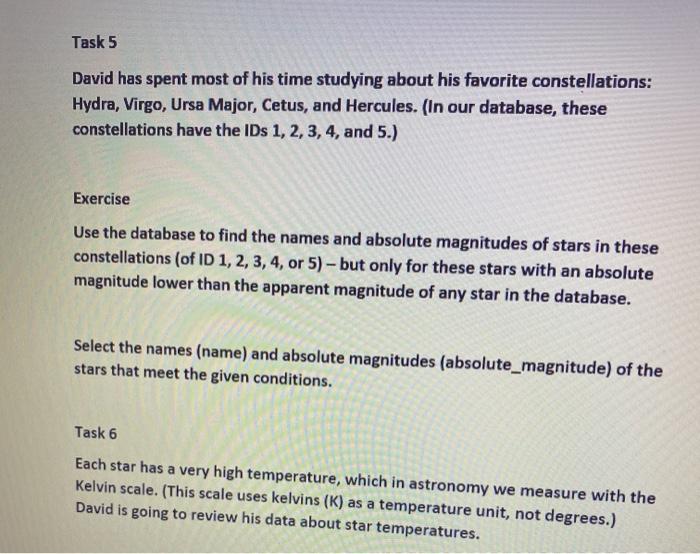
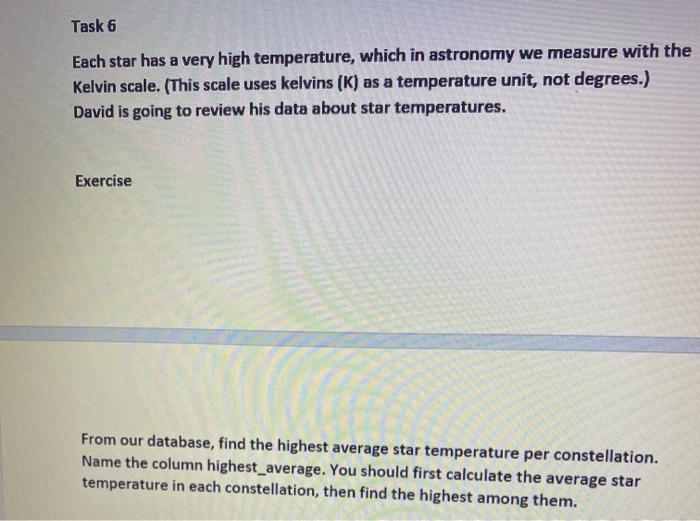

Task 3 David knows some constellations have greater area than others. Let's help him find specific info on that. Exercise How many constellations have greater area than the average area across all constellations? Select the number of these constellations (name the column count_constellations). Task 4 January is one of David's favorite months for stargazing. Today, he's looking for the brightest star and wants to know which stars are the brightest - but only for constellations with an area greater than 1,000. Task 4 January is one of David's favorite months for stargazing. Today, he's looking for the brightest star and wants to know which stars are the brightest - but only for constellations with an area greater than 1,000. Exercise Select the name(s) of the brightest star(s) in constellations with an area over 1,000. Show the star name (as star_name) and the constellation name (as constellation_name). Remember that the brighter a star appears from Earth, the lower its apparent magnitude. (In the star table, the name of the column is apparent_magnitude.) Task 5 David has spent most of his time studying about his favorite constellations: Hydra, Virgo, Ursa Major, Cetus, and Hercules. (In our database, these constellations have the IDs 1, 2, 3, 4, and 5.) Exercise Use the database to find the names and absolute magnitudes of stars in these constellations (of ID 1, 2, 3, 4, or 5) - but only for these stars with an absolute magnitude lower than the apparent magnitude of any star in the database. Select the names (name) and absolute magnitudes (absolute_magnitude) of the stars that meet the given conditions. Task 6 Each star has a very high temperature, which in astronomy we measure with the Kelvin scale. (This scale uses kelvins (K) as a temperature unit, not degrees.) David is going to review his data about star temperatures. Task 6 Each star has a very high temperature, which in astronomy we measure with the Kelvin scale. (This scale uses kelvins (K) as a temperature unit, not degrees.) David is going to review his data about star temperatures. Exercise From our database, find the highest average star temperature per constellation. Name the column highest_average. You should first calculate the average star temperature in each constellation, then find the highest among them. Task 7 David would like to know what is the distances between the Sun and the stars. Exercise Find the distances between the Sun and a star whose name starts with A. This star also belongs to a constellation whose name starts with A. Select the constellation name (as constellation_name), the name of the star (as star_name), and the distance from this star to the Sun, as described. Task 3 David knows some constellations have greater area than others. Let's help him find specific info on that. Exercise How many constellations have greater area than the average area across all constellations? Select the number of these constellations (name the column count_constellations). Task 4 January is one of David's favorite months for stargazing. Today, he's looking for the brightest star and wants to know which stars are the brightest - but only for constellations with an area greater than 1,000. Task 4 January is one of David's favorite months for stargazing. Today, he's looking for the brightest star and wants to know which stars are the brightest - but only for constellations with an area greater than 1,000. Exercise Select the name(s) of the brightest star(s) in constellations with an area over 1,000. Show the star name (as star_name) and the constellation name (as constellation_name). Remember that the brighter a star appears from Earth, the lower its apparent magnitude. (In the star table, the name of the column is apparent_magnitude.) Task 5 David has spent most of his time studying about his favorite constellations: Hydra, Virgo, Ursa Major, Cetus, and Hercules. (In our database, these constellations have the IDs 1, 2, 3, 4, and 5.) Exercise Use the database to find the names and absolute magnitudes of stars in these constellations (of ID 1, 2, 3, 4, or 5) - but only for these stars with an absolute magnitude lower than the apparent magnitude of any star in the database. Select the names (name) and absolute magnitudes (absolute_magnitude) of the stars that meet the given conditions. Task 6 Each star has a very high temperature, which in astronomy we measure with the Kelvin scale. (This scale uses kelvins (K) as a temperature unit, not degrees.) David is going to review his data about star temperatures. Task 6 Each star has a very high temperature, which in astronomy we measure with the Kelvin scale. (This scale uses kelvins (K) as a temperature unit, not degrees.) David is going to review his data about star temperatures. Exercise From our database, find the highest average star temperature per constellation. Name the column highest_average. You should first calculate the average star temperature in each constellation, then find the highest among them. Task 7 David would like to know what is the distances between the Sun and the stars. Exercise Find the distances between the Sun and a star whose name starts with A. This star also belongs to a constellation whose name starts with A. Select the constellation name (as constellation_name), the name of the star (as star_name), and the distance from this star to the Sun, as described












